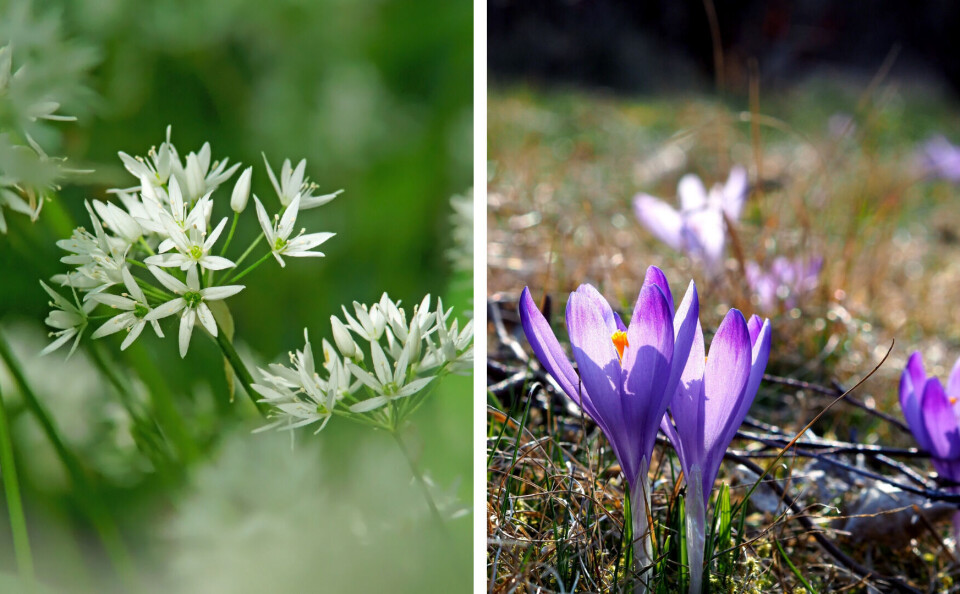-
Strikes and protests in January 2026 and how you may be affected
Doctors, rail staff, and farmers are all taking action
-
Good news as lower electricity bills confirmed in France
The change is not a ‘revolution’ but will give some purchasing power back, minister says
-
French ski resorts report excellent Christmas despite less snow than last year
Bookings are up and non-snow related activities are also on the rise
Be careful eating wildflowers on spring walks, warns health agency
Confusing wild garlic for colchicum could have fatal consequences

For many, pleasant walks through France’s lush countryside and meadows is a sign that spring is well underway.
Reminders have been issued to ramblers, however, to act with caution and refrain from ingesting plants they are unsure of – as the results could be lethal.
Similarities between the perfectly edible wild garlic (ail d’ours) and dangerous colchique, or colchicum, have led to a number of cases of poisoning for walkers in rural France.
Between 2020 and 2022, almost 30 hospitalisations – and two deaths – were recorded due to ingesting the colchicum.
Both plants are found in the Grand Est and Occitanie regions of France, where the majority of incidents took place.
Many similarities – and a lethal difference
The warning was issued by health agency ANSES (Agence nationale de sécurité sanitaire de l’alimentation, de l’environnement et du travail), in a bid to prevent fatalities from colchique ingestion this year.
Also known as autumn crocus, meadow saffron and naked lady, the plant looks similar to wild garlic but unlike its edible counterpart, colchicum cannot be consumed due to its toxicity.
Although colchicum primarily blooms in autumn, it can be present in spring, especially in the undergrowth – just like wild garlic.
“They [wild garlic and colchicum] belong more or less to the same group of plants," Sophie Nadot, professor of botany at the University of Paris-Saclay, told FranceInfo. "They all have green, fairly simple, elongated leaves with parallel veins,” she added.
And it is precisely the similarity between these leaves which causes such problems, as people mistakenly pick the leaves of colchicum plants to use in recipes instead of wild garlic, explains ANSES.
“The severity of the intoxication depends on [the quantity ingested],” the agency added, stressing that all parts of the plant are highly toxic to humans and a host of other animals including cats.
Read more: Five of France’s most beautiful coastal walks to try this summer
How can I tell them apart?
Despite the similarities, it is possible to tell the difference between the leaves of the two plants.
"[Wild garlic] leaves are oval, with a wider part in the middle, they all start from the base and are flexible," said Ms Nadot.
In contrast, the colchicum's leaves are "stiffer, without stems and the bulb is round and dark", says ANSES.
You can also spot differences between their flowers due to the colour differences.
Colchicum has a “mauve-coloured flower… large and fairly elongated in shape,” said Ms Nadot, whereas the white flowers of wild garlic “form like stars.”
“Each flower is about 1cm in diameter, with a small green ball, the pistil, in the centre. The flowers are arranged in a head… [and they] form large mats, there are seldom any individual plants,” added the botanist.
Colchicum flowers only bloom in autumn, however, meaning this distinction is not available to spring ramblers.
Another way to differentiate them is via their smell – wild garlic “has a characteristic garlic smell when its leaves are crumpled," explained ANSES (hence the name), which autumn crocus does not have.
Although you cannot be poisoned by merely touching colchicum, you should nonetheless wear gloves if planning to handle it, to be on the safe side.
Read also: Chestnuts vs conkers: Know the difference when out gathering in France
If ingested, seek help
Ingestion of the colchicum can lead to typical signs of poisoning - vomiting, diarrhoea, dizziness, as well as alopecia, cardiac arrest and even a coma.
To limit any lethal accidents, ANSES recommends to “stop eating immediately if the plant has an unusual or unpleasant taste", and "not pick [the flowers] in batches” to avoid picking several species.
If you think you have been poisoned after eating wild plants and have severe symptoms, you should contact the emergency services,
In all other cases, you should call the poison control centre (centre antipoison) or consult a doctor.
The centre antipoison has a list of regional helplines available 24 hours, which you can find here.
Related articles
Protected forest cats come back from the brink of extinction in France
Hikers in France warned against building ‘cairns’ on trails and paths
























